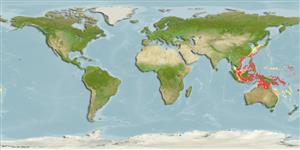Teleostei (teleosts) >
Gobiiformes (Gobies) >
Gobiidae (Gobies) > Gobiinae
Etymology: Trimma: Greek, trimma, -atos = something crushed (Ref. 45335); yanoi: Named for Mr. Korechika Yano, who provided the types of the new species..
Environment: milieu / climate zone / depth range / distribution range
Ecology
Marine; demersal; depth range 8 - 70 m (Ref. 90102). Temperate
Western Pacific: Philippines, Indonesia, Ryukyu Is., and Japan.
Size / Weight / Age
Maturity: Lm ? range ? - ? cm
Max length : 2.2 cm SL male/unsexed; (Ref. 75202); 2.1 cm SL (female)
Short description
Identification keys | Morphology | Morphometrics
Dorsal spines (total): 7; Dorsal soft rays (total): 10; Anal spines: 1; Anal soft rays: 9; Vertebrae: 26. This species can be distinguished from its congeners by the following characters: higher anterior (16-16.5) and posterior (15.5-16) transverse scale counts (vs. <13); without scales on predorsal midline; elongate spines of first dorsal fin absent; fifth pelvic-fin ray branched, 60-64% of fourth ray in length; basal membrane between innermost pelvic-fin rays 61-64% of length of fifth ray; without interorbital or postorbital trough; 24-26 longitudinal scales; body scales gradually increase in size posteriorly with scales on lateral midline largest; ground color of head and body semi-translucent and deep red, a dark grayish brown broken stripe on upper part of opercle when fresh (Ref. 75202).
Inhabits coral reef caves and crevices in 8-70 m (Ref. 90102).
Life cycle and mating behavior
Maturities | Reproduction | Spawnings | Egg(s) | Fecundities | Larvae
Suzuki, T. and H. Senou, 2008. Two new species of the gobiid fish genus Trimma (Perciformes: Gobioidei) from Southern Japan. Bull. Natl. Mus. Nat. Sci. Ser. A. Suppl. 2:97-106. (Ref. 75202)
IUCN Red List Status (Ref. 130435)
Threat to humans
Harmless
Human uses
Tools
Special reports
Download XML
Internet sources
Estimates based on models
Preferred temperature (Ref.
123201): 25.5 - 28.9, mean 28 °C (based on 238 cells).
Phylogenetic diversity index (Ref.
82804): PD
50 = 0.5000 [Uniqueness, from 0.5 = low to 2.0 = high].
Bayesian length-weight: a=0.01023 (0.00477 - 0.02194), b=3.02 (2.84 - 3.20), in cm total length, based on LWR estimates for this (Sub)family-body shape (Ref.
93245).
Resilience (Ref.
120179): High, minimum population doubling time less than 15 months (Preliminary K or Fecundity.).
Fishing Vulnerability (Ref.
59153): Low vulnerability (10 of 100).
